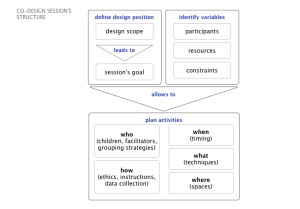framework on co-design sessions with children
PhD thesis: Designing with Children: Reflections on Effective Involvement of Children in the Interaction Design Process
With my PhD research I explored a way to ease the organisation of co-design sessions with children through reflective practice by providing an understanding of the practice and its implications.
The research followed a design research process, with the emphasis on the exploration and investigation of the context of the co-design practice with children. The framework resulting from this research aims to assist design practitioners, especially less experienced ones, in taking decisions when planning and coordinating co-design sessions in a flexible way that can be applied to different design situations.
Supervisors: Prof. Janet Read, (UCLan, UK); Prof. Russell Beale, (University of Birmingham, UK).


mobile device for music application
UMSIC – Usability of Music for Social Inclusion of Children (2008-2011)
(Project Reference: FP7-ICT-2008-224561)

My tasks within the project:
- evaluating design concepts with users
- eliciting users requirements
- coordinating design partners
- design project logo
Related Publications
Mazzone, E., Tikkanen, R., Read, J.C., Iivari, N., and Beale, R. “Integrating Children’s Contributions in the Interaction Design Process”. International Journal of art and Technology, Vol. 5, Nos. 2/3/4, pp.319–346 (2012)
Mazzone, E., Iivari, N., Tikkanen, R., Read, J.C., and Beale, R. “Considering context, content, management, and engagement in design activities with children”. Proceedings of the 9th International Conference on Interaction Design and Children, (2010), 108-117.
Fredrikson, M., Welch, G., Porras, J., Paananen, P., Read, J., Stadler Elmer, S., Heikkinen, K., Myllykoski, M., Hedberg, H., Iivari, N. & Mazzone, E. (2009): Music as an Enabler for Social Inclusion and Provision – The UMSIC approach. In P. L. Emiliani, L. Burzagli, A. Como, F. Gabbani & A-L. Salminen (Eds.) Assistive Technology from Adapted Equipment to Inclusive Environments, IOS Press, Amsterdam. Pp. 622-627.
interactive museum schoolvisits
BEAM – Broadband Enhancement of Activities for Museum (2006)

Funded by the Lancashire Digital Development Agency (LDDA) and in collaboration with the Lancashire County Museum Services. I worked in this research project with the ChiCI group at University of Central Lancashire (UK). The project aimed at enhancing children’s experience allowing them to use novel technologies in the museum environment, whilst supporting learning activities with pre- and post-visit interaction via the internet.
My tasks within the project:
- field observation in local museums
- requirements gathering from children, teachers, museum staff
- co-design sessions with children
- mock-ups
- evaluation with users in the field
Related Publications
Mazzone, E., Read, J.C., Beale, R. (2008) “Understanding Children’s Contribution during Informant Design” in Proceedings of the British HCI Conference 2008, Liverpool, UK, ACM Press
Kelly, R., Mazzone, E., Horton, P., Read, J. (2006) “Bluebells: A Design Method for Child-Centred Product Development”. in Proceedings of NordiCHI 2006, Oslo, Norway. ACM Press
Read, J., Kelly, R., Mazzone, E., Horton, M. (2006) “Bluebells: Designing and Fun”, in Proceedings of the Fun and Games 2006 Conference, Preston, UK
interesting subject. I am doing my masters and I was wondering what ethical, social and legal implications that may arise with reference to interaction design for children in relation to its usage in an educational environment.
Hi Jenny, thanks for your message.
ethical/legal issues vary a lot depending on many factors – drop me an email if you like to discuss it more in detail and see if i can help. good luck with your master!